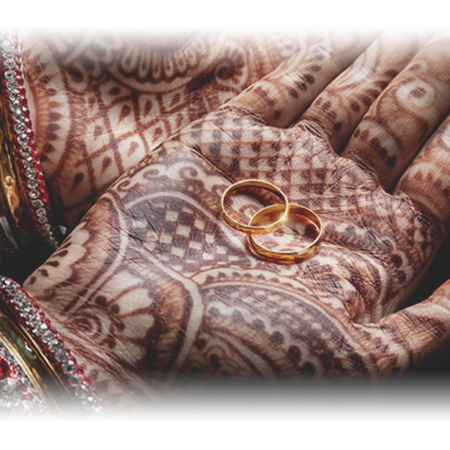Culture Club: India

A few weeks ago, we delved into some Mexican wedding traditions in our first installment in the Culture Club series. Today, we’ll be looking at some Indian wedding traditions in more detail.
As you probably know, India is the second most populous country in the world, second only to China. With a population of just over 1.3 billion people, India accounts for about one-fifth of the world’s population. With 1.3 billion people, I would reckon that their wedding business is booming! I can’t think of a better place to expand our cultural horizons than in India.
Although India is home to people of many different faiths, a whopping 79.8% of their population is Hindu (as of 2015). One of the biggest differences in Indian weddings is the fact that they often last several days. Over the course of three or four days, different rituals and ceremonies are performed, with clothing changes each day to match. The myriad variations and regional rituals and activities surrounding a traditional Hindu wedding ceremony are vast, but there are three rituals that are common in almost all Hindu weddings (with regional variations of course).
First, in the kanyadaan ritual, the bride is given away by her father. The father takes his daughter’s hand and places it in the groom’s. A verse from the Kamasukta (NOT to be confused with the Kama Sutra, mind you) is recited and then the groom promises to the father that he will not fail his bride in his pursuit of a moral and lawful life, wealth, and love.
Next, the panigrahana ritual is performed. Prior to this ritual being performed, the groom lights a sacred fire (since the primary witness of a Hindu wedding is the Sacred Fire, Agni (the fire deity)). This fire represents the formations of a new household. In front of this fire, the groom sits facing west, with his bride seated before him facing east. This ceremony includes the pronouncement of the acceptance of the responsibilities levied on the groom by four deities, representing wealth, the heavens, new beginnings, and wisdom.
The most important part of the wedding, and the ritual that makes a Hindu wedding legally binding, is the saptapadi ritual. Circling the sacred fire, the couple, led by the groom, completes the seven circuits of the Holy Fire. In this ritual, the bride and groom either hold hands or have articles of clothing (her sari and his scarf for example) tied together. This ritual is most comparable to the Western tradition of reciting vows. In India, since 1955, the saptapadi must be completed in order for a Hindu marriage to be legally, socially, or religiously recognized. However, this requirement is currently under debate.
Another area in which the differences in Indian and Western weddings can be seen is in the traditional wedding attire and accessories. Brides will generally wear saris or lehengas (long skirts that are pleated and extensively embroidered and embellished). As in China, red is seen as the most auspicious color for weddings. Most Indian brides will not be wearing a fluffy white princess ball gown like I did for my wedding. The bride’s wedding clothes will be red, very ornate, and a feast for the eyes.
One of the most impressive aspects of an Indian wedding is the jewelry. Almost all the jewelry worn by the bride (and sometimes groom) will be yellow gold, usually of a very high karat, if not 24 karat gold (which is pure gold). The bride is literally dripping with gold jewelry. From hair adornments, necklaces, earrings (often with connected nose rings if her nose is pierced, as most Hindu girls’ are), bangles, anklets, and other foot jewelry, the bride’s gold wedding jewelry can easily represent one-third of the money the bride’s family spends on the wedding.
Gold jewelry has long-standing significance in Indian weddings. Gold jewelry is seen as a good omen, a sign of the bride being blessed by the goddess Lakshmi. The groom’s parents perceive it as a sign of good luck if the bride enters the home and marriage with gold jewelry. Gold jewelry is also seen as a practical investment in the bride and married couple, as the parents “secure” their daughter’s future by sending her to her husband’s home with gold of her own. And it is further seen as a security for the married couple’s future children and retirement. Essentially, it is a way for young couples to build their nest egg.
I would be remiss if I didn’t mention one of the most recognizable Indian wedding traditions: mehndi. Mehndi is a skilled art that can be most likened to a long-term temporary tattoo. A paste is made from the powdered leaves of the henna plant. This paste is drawn onto the skin, most often on the hands, feet, palms, and arms, in patterns and motifs that have varied meanings. The paste is left on the skin until it dries. When it is rinsed off, it reveals dyed skin underneath.

Honestly, the picture I’ve painted for you about Indian wedding traditions just barely scratches the surface. I hope though that I have ignited in you a desire for more knowledge about the incredible rituals, ceremonies, and ways of life of the cultures found on the Indian subcontinent.
Until next time,
Rebecca
Share This Page:












